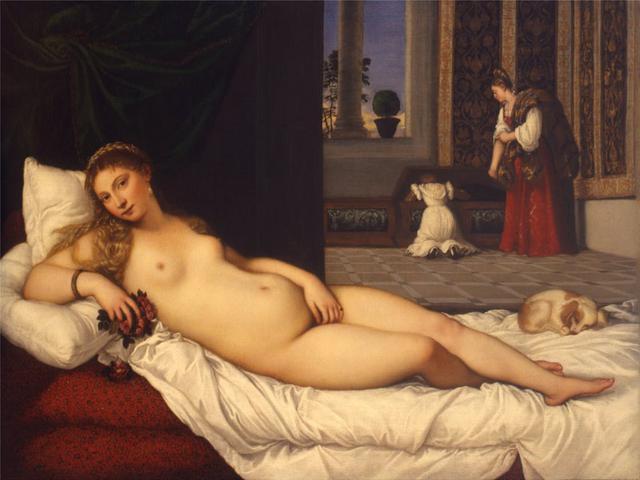Venus of Urbino

This is one of Titian's most famous works and represents the emblematic figure of a young bride about to dress to participate in the celebration of the ritual known in Venice as "il toccamano". It was a ceremony held in the home and not in the church, during which a young woman whose hand was sought in marriage would touch the groom's hand to express her consent. Titian takes this as his inspiration for a seductive Venus, using iconography that began in the early Renaissance, inspired by the ancient representation of the "Venus pudica." The girl, lying naked on a bed with wrinkled sheets, looks at the viewer in a flirtatious and allusive manner, while hiding her pubis with her left hand and holding a bouquet of roses, the emblem of Venus and of the pleasure and constancy of love in his right. At the foot of the bed, the sleeping dog, the same one that appears in another Titian in the Uffizi, the portrait of Eleonora Gonzaga, is a reference to fidelity in marriage. The background shows an elegant room in the distinctive style of a wealthy patrician house in 16th century Venice. There are two maids, one of whom is trying to search the painted chest from which she has just removed the sumptuous blue and gold wedding dress that can be seen on the shoulder of the other maid, standing to the right. On the windowsill there is a pot of myrtle, a traditional plant linked to Venus, and one more reference to the constancy in love that the dog at the foot of the bed already alludes to.
In this canvas, Titian can confirm his extraordinary talent in giving intensity and character to his subject, as well as his unmatched ability to portray the softness of the skin and the quality of the materials. As certified in a letter of 1538, the painting of the "naked woman" was purchased directly from Titian by Guidobaldo II della Rovere and was brought to Florence as part of the dowry of Vittoria della Rovere, the last member of the family and wife of Grand Duke of Tuscany, Ferdinando II de' Medici. For many years, the painting was on display in the Tribuna degli Uffizi, near the Medici Venus, probably as an intentional comparison between the two provocative beauties: the ancient, classical and idealized statue, and the modern, carnal painting of Titian.
© Tourblink